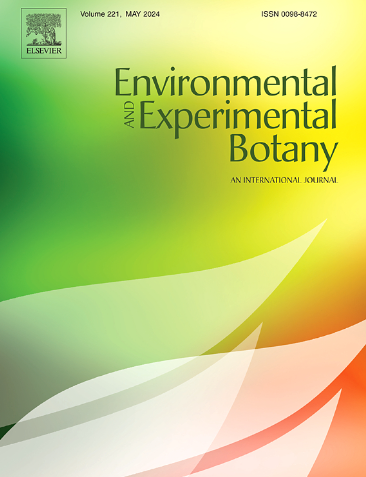PIN7和AUX1对亚砷酸盐抑制拟南芥根系生长的响应
IF 4.7
2区 生物学
Q2 ENVIRONMENTAL SCIENCES
引用次数: 0
摘要
亚砷酸盐(AsIII)是一种危害人类健康和食品安全的物质,它能抑制根的生长。这一事件很少受到关注,AsIII如何影响生长素抑制根生长的机制尚不清楚。在此,我们的研究结果表明,asiii抑制根生长可能与根中生长素水平升高有关,这在多个实验中得到了支持,如:(1)转基因DII-VENUS和DR5rev::GFP;(2)酶联免疫吸附法测定IAA;(3)生长素合成缺陷taa1突变体表型分析;(4)外用1-萘基酞酸(NPA)调控生长素运输。这一结果可以通过整个植物中生长素生物合成相关基因的转录水平上调来解释。生长素转运相关载体的表型显示,PIN7和AUX1的缺失,而不是PIN1/2/3转运体的缺失,改善了asiii诱导的根生长抑制的程度。此外,AsIII特异性增强了pm定位的PIN7和AUX1的丰度,这些PIN7和AUX1参与转录调控,但不参与转录后调控。利用转基因pPIN2::PIN2- dendra2细胞系对pm定位的PIN2进行了实时体外观察,结果表明,AsIII不影响pm定位的PIN2载体在根尖的内噬作用。综上所述,我们的研究结果表明,AsIII胁迫下根尖生长素水平升高可能涉及到生长素生物合成和生长素运输相关基因的转录水平上调,而不是针对PIN2动态,最终导致生长素在根尖积累,抑制根生长。本文章由计算机程序翻译,如有差异,请以英文原文为准。
Coordinated PIN7 and AUX1 responses to arsenite-restrained root growth in Arabidopsis
Arsenite (AsIII), regarded as a hazard to human health and food safety, restrains root growth. This event has received little attention, and the mechanism underlying how AsIII affects auxin dynamics to repress root growth remains unknown. Here, our results have suggested that AsIII-inhibited root growth possibly involved an elevated auxin level in roots, as supported in multiple experiments such as (1) transgenic DII-VENUS and DR5rev::GFP; (2) IAA determination by enzyme-linked immunosorbent assay; (3) phenotype analysis of taa1 (defective in auxin biosynthesis) mutant; and (4) the external application of 1-naphthylphthalamic acid (NPA) to manipulate auxin transport. This consequence could be explained through up-regulated transcriptional levels of auxin biosynthesis-related genes in whole plants. Phenotypes of auxin transport-related carriers have displayed that loss of PIN7 and AUX1, but not PIN1/2/3 transporters, ameliorated the extent of AsIII-induced root growth inhibition. Moreover, AsIII specifically enhanced the abundance of PM-localized PIN7 and AUX1 involved in transcriptional but not post-transcriptional regulation. A real-time in vitro observation of PM-localized PIN2 using the transgenic pPIN2::PIN2-Dendra2 line has revealed that AsIII did not influence the endocytosis of PM-localized PIN2 carriers in root apices. Overall, our results propose that AsIII stress-elevated auxin level in the root apex possibly involves up-regulation transcriptional levels of auxin biosynthesis- and auxin transport-related genes but does not target PIN2 dynamics, finally, leading to auxin accumulation in root apices and root growth inhibition.
求助全文
通过发布文献求助,成功后即可免费获取论文全文。
去求助
来源期刊

Environmental and Experimental Botany
环境科学-环境科学
CiteScore
9.30
自引率
5.30%
发文量
342
审稿时长
26 days
期刊介绍:
Environmental and Experimental Botany (EEB) publishes research papers on the physical, chemical, biological, molecular mechanisms and processes involved in the responses of plants to their environment.
In addition to research papers, the journal includes review articles. Submission is in agreement with the Editors-in-Chief.
The Journal also publishes special issues which are built by invited guest editors and are related to the main themes of EEB.
The areas covered by the Journal include:
(1) Responses of plants to heavy metals and pollutants
(2) Plant/water interactions (salinity, drought, flooding)
(3) Responses of plants to radiations ranging from UV-B to infrared
(4) Plant/atmosphere relations (ozone, CO2 , temperature)
(5) Global change impacts on plant ecophysiology
(6) Biotic interactions involving environmental factors.
 求助内容:
求助内容: 应助结果提醒方式:
应助结果提醒方式:


